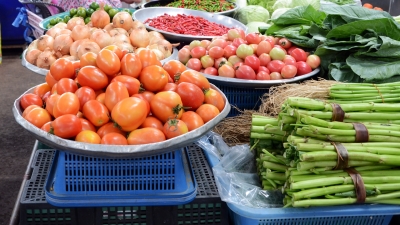Farmers Markets to Lower Blood Pressure with the DASH Diet

This Dietary Approaches to Stop Hypertension (DASH) diet is recommend to manage high blood pressure. This diet is rich in fruits and vegetables. You need to consume between three to five servings of vegetables daily and between four to five fruits daily. That likely sounds overwhelming, but it can be effective in your efforts to lower blood pressure.
One vegetables serving is equal to 1 cup raw leafy green vegetable, ½ cup cut-up raw or cooked vegetables, or ½ cup vegetable juice.
One fruit serving is equal to 1 medium fruit, ¼ cup dried fruit, ½ cup fresh, frozen, or canned fruit, or ½ cup 100% fruit juice.
It’s the perfect time of year to adopt the DASH diet if you are struggling with high blood pressure. Many varieties of produce are in season and farmers markets are readily available.
3 Benefits of Shopping at Farmers Markets
- Farmers markets are environmentally friendly. The food is produced and sold locally, while food in grocery stores travels an average of 1500 miles before it reaches your plate.
- Produce grown for farmers markets is typically allowed to fully ripen naturally before it is harvested. Nothing is used to speed up the ripening process.
- The produce purchased at a farmers market comes straight from the garden. No processing. This equals fresh and nutrient rich food.
Tips for Shopping at Farmers Markets
Shopping at a farmers market is not the same as going to the grocery store.
Here is are a few items separated by season. However, what is in season varies depending on where you live. Use this tool to narrow it down to your location and the season.
Summer (June, July, August) – beets, bell peppers, blackberries, blueberries, boysenberries, cantaloupe, cherries, cucumbers, eggplant, grapefruit, green beans, lima beans, nectarines, peaches, radishes, strawberries, tomatoes, watermelon, zucchini
Fall (September, October, November) – acorn squash, broccoli, brussels sprouts, cauliflower, crab apples, cranberries, ginger, mushrooms, pear, pomegranate, sweet potatoes, turnips
Winter (December, January, February) – chestnuts, clementines, kiwifruit, leeks, red currants, turnips
Plan your meals in advance
If you go to a farmers market and don’t know what you need or what you will use a particular produce for, you will likely come home with items that will go bad before they are eaten.
First, check what is in season. Second, plan your meal/find a recipe. Third, go to the farmers market to find the item you need.
Arrive early
For best selection and freshest option arrive when the market opens.
Stock up for later
Remember, you can use produce from a farmers market to feed you and your family year round. Can, preserve, and pickle what you find! Do some research so your preservation method is low sodium and doesn’t promote high blood pressure.
Find a Farmers Market in Your Area
If you Google “farmers markets” the results will likely list local options first. If that is not the case, the USDA does have a farmers market directory you may search.
If you are working to lower blood pressure, sign up for the free ecourse 7 Natural Ways to Lower Blood Pressure at http://lowerbloodpressurewithlisa.com.
All the best,
Lisa Nelson RD
Health Pro for HealthCentral
Image courtesy of Sira Anamwong / FreeDigitalPhotos.net



